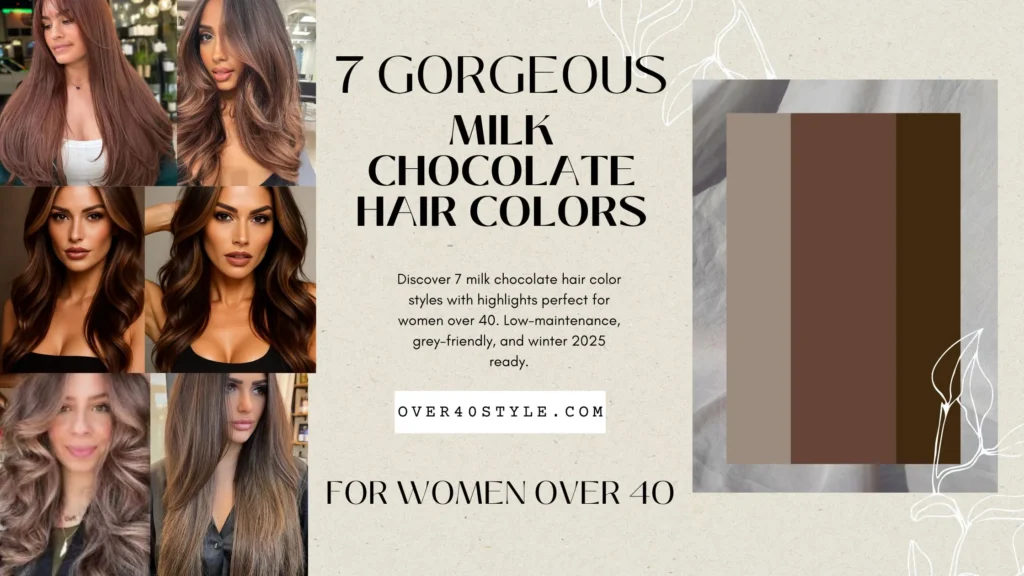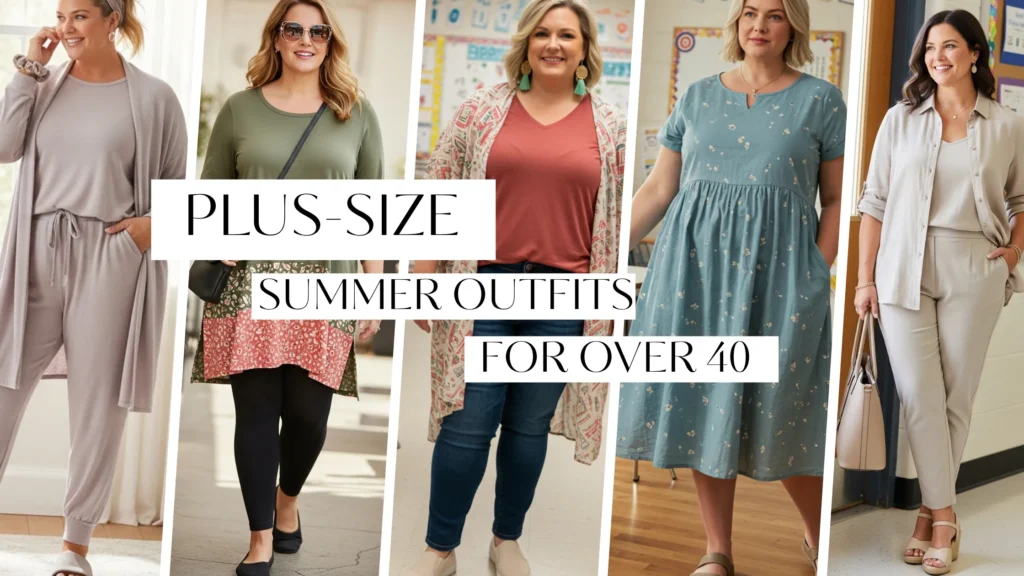Milk chocolate hair color with highlights is one of the most flattering choices for women over 40 in winter 2025. This warm, dimensional shade offers natural grey coverage, requires minimal maintenance, and complements mature skin tones beautifully.
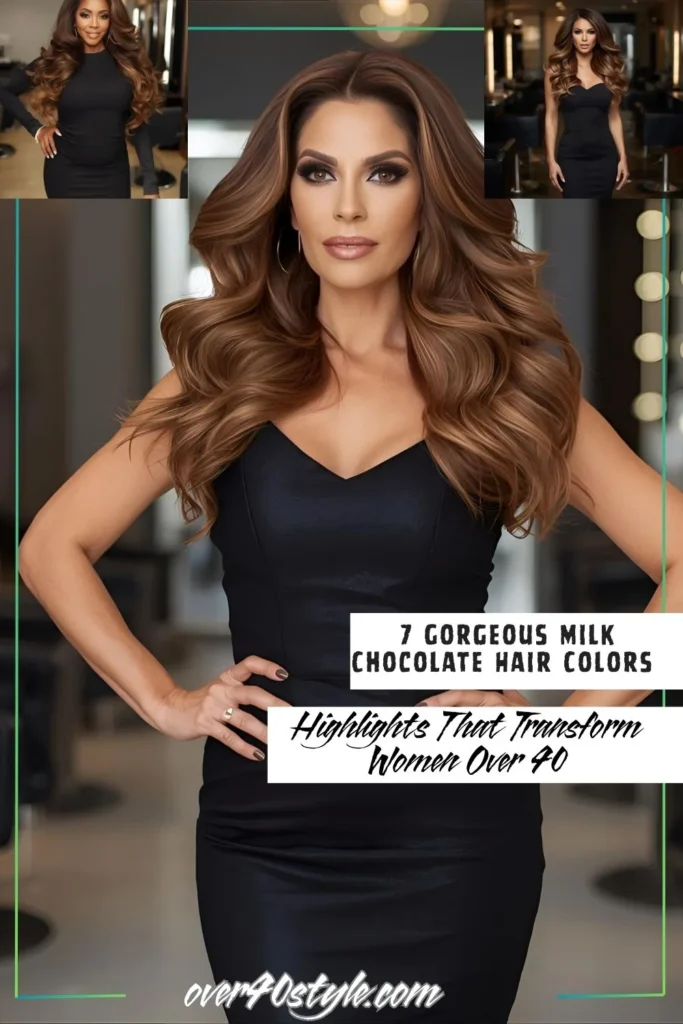
Unlike flat single-process colors, milk chocolate brown with highlights creates depth and movement. The result is a sophisticated look that grows out gracefully without harsh regrowth lines. Whether you prefer subtle caramel ribbons or bolder contrast highlights, this versatile color adapts to your personal style.
Here are seven stunning milk chocolate hair color combinations that deliver salon-quality results while fitting your busy lifestyle.
What Makes Milk Chocolate Hair Color Perfect for Winter?
Milk chocolate sits in that sweet spot between medium and dark brown—rich enough to provide excellent grey coverage yet warm enough to prevent that harsh, aging effect of jet black hair. Think of it as your hair’s version of comfort food: familiar, flattering, and always appropriate.
The warmth in milk chocolate hair color with highlights becomes especially valuable during winter months when natural light decreases and we spend more time under artificial lighting. Cool or ashy browns can make mature skin appear washed out under indoor lights, while milk chocolate creates a natural glow that flatters your complexion regardless of lighting conditions.
This base color also plays beautifully with winter’s color palette. Your burgundy sweaters, camel coats, and jewel-tone holiday outfits all harmonize with chocolate tones, creating a pulled-together aesthetic that feels effortless. Plus, the slight warmth prevents your hair from blending too much with dark winter clothing, maintaining visibility and dimension.
Table of Contents
1. Milk Chocolate Hair with Caramel Highlights: The Classic Choice
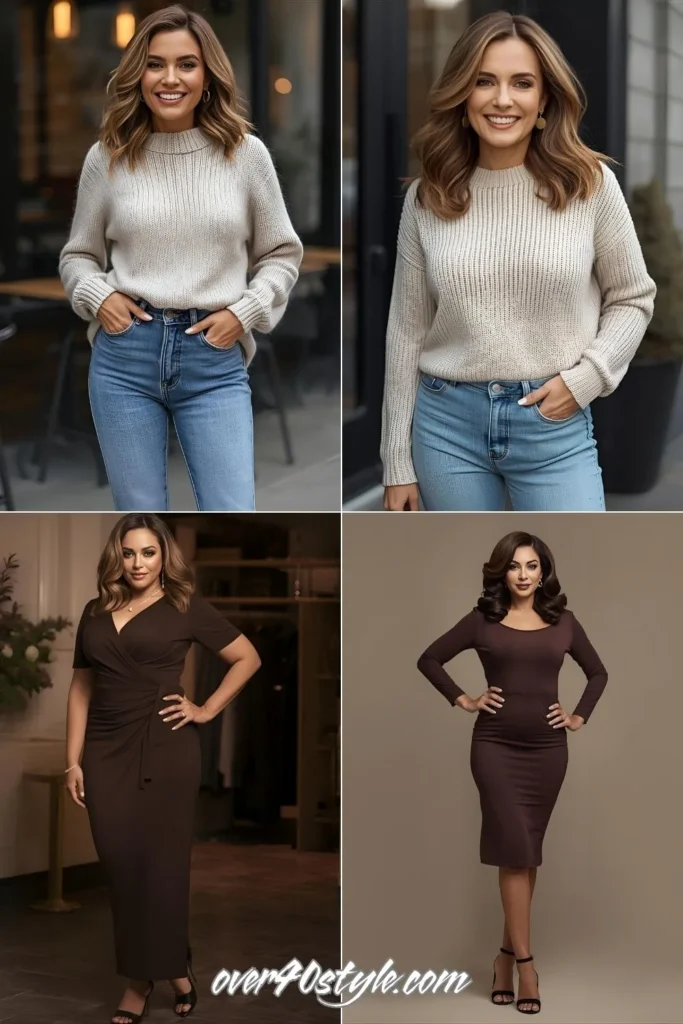
Caramel highlights on a milk chocolate base remain the top requested color for women over 40. This combination adds natural dimension without appearing overly styled. The warm caramel shades work well with grey hair, so regrowth between salon visits stays subtle.
The blended technique means you’ll visit your colorist every 6–8 weeks, which is less often than solid color requires. New growth blends in rather than creating obvious root lines.
Who Should Choose This Style
Women with warm or neutral undertones get the best results. If you look better in gold jewelry than silver, these highlights will suit your skin tone. The golden shades complement peachy, olive, or tan complexions especially well.
Winter Color Benefits
Indoor lighting in winter makes caramel tones catch the light, creating depth that compensates for flat natural light. This works well for holiday events and office settings where you want to look polished.
Maintenance Overview
- Salon appointments: Every 6–8 weeks
- Home care: Color-depositing conditioner weekly
- Commitment level: Medium upkeep
- Appointment length: 2–3 hours with highlights
How to Style It
Loose waves or soft curls display the dimensional color best. A side part creates shadows that enhance the highlight placement. Apply a lightweight shine serum to manage static and maintain gloss through dry winter conditions.
Common Pitfall
Requesting too many caramel pieces results in brassy, harsh orange tones. Keep highlights focused on your face and extending to the crown for natural-looking, manageable color.
2. Blonde Balayage on Milk Chocolate Hair
Ready for something more contemporary? Blonde balayage on milk chocolate hair color with highlights offers a fashion-forward approach that feels modern without requiring full blonde commitment. This hand-painted technique creates gradual transition from your chocolate base to honey or golden blonde ends.
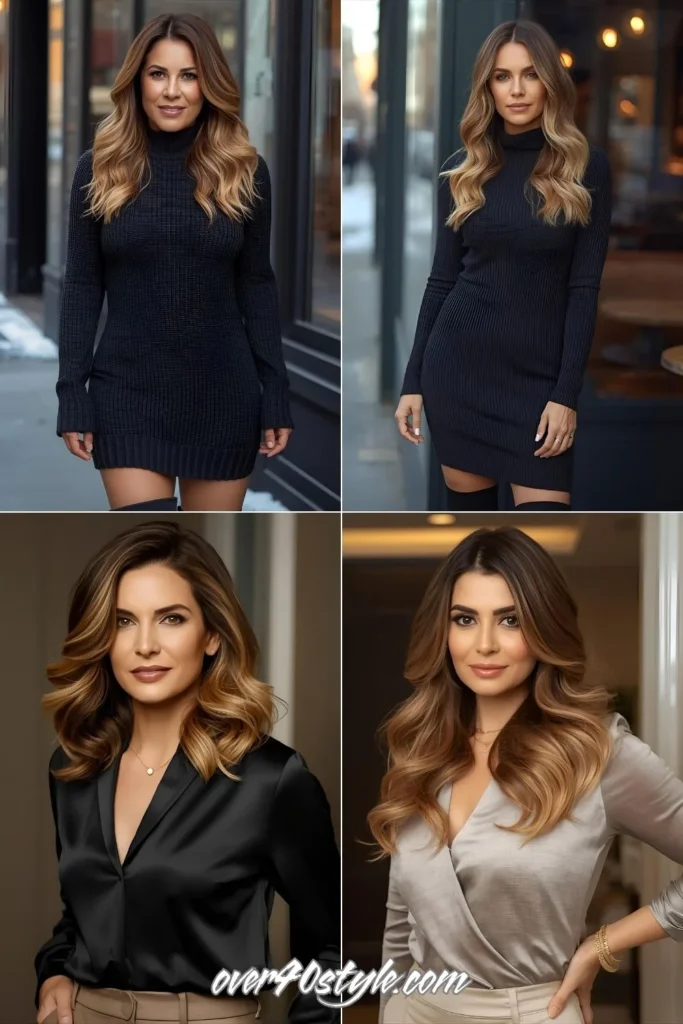
Balayage excels at creating that youthful, sun-lightened effect that’s particularly striking during winter when natural sunlight becomes scarce. The blonde pieces brightening your face draw attention to your eyes and cheekbones while softening fine lines naturally.
Who This Suits
Women with cool to neutral skin tones wanting a contemporary look. This style works beautifully if you’re transitioning from darker hair and want gradual lightening rather than dramatic change.
Winter makes blonde balayage especially striking because the contrast against dark clothing creates visual drama. The dimensional effect appears more pronounced indoors, perfect for the season’s predominantly interior lifestyle.
Maintenance surprises people with its low demands. Because balayage is painted freehand without clear demarcation lines, it grows out gracefully over three to four months. You’ll need toning appointments every four to six weeks preventing brassiness—essential during dry winter months when hard water affects color.
Embrace natural texture with milk chocolate hair color with highlights in balayage form. Whether your hair falls straight, wavy, or curly, balayage enhances movement beautifully. Apply purple-toning masks weekly during winter, combating yellowing from indoor heating and mineral-heavy water.
Choose honey, golden, or butterscotch blonde rather than platinum or ash shades. These warmer tones require less bleach processing on mature hair while delivering the warmth that flatters 40+ skin tones.
3. Milk Chocolate Hair with Subtle Lowlights
Lowlights add depth without brightness. This technique places darker chocolate or espresso tones through your base color to create shadow and natural movement.
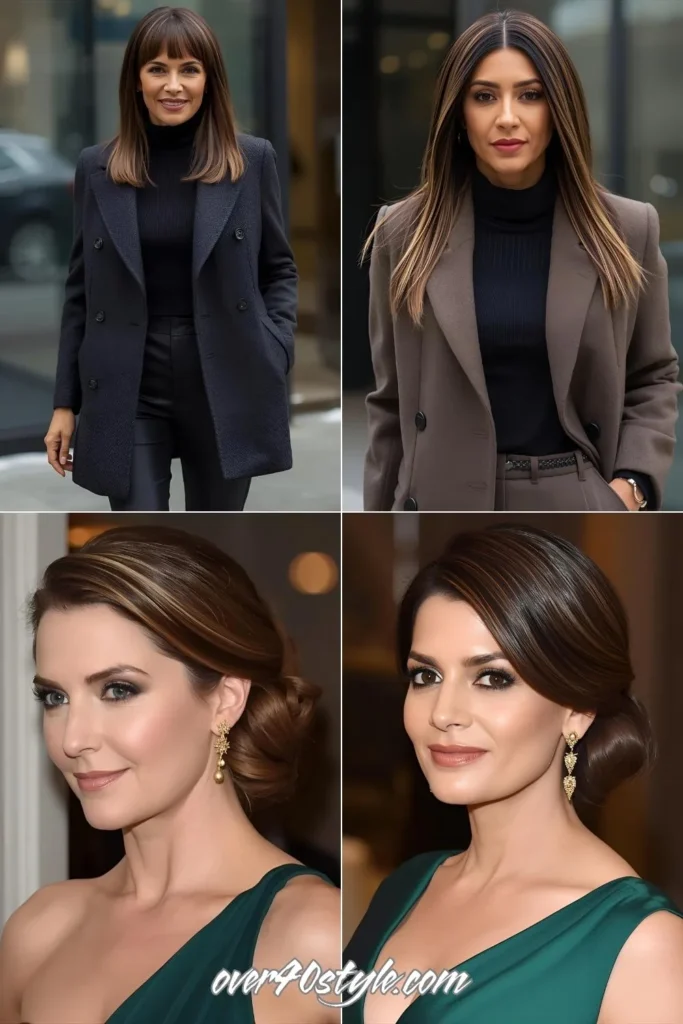
This method works especially well for women with thinning hair. The contrast between your lighter base and darker lowlight sections makes hair appear fuller and thicker. You get added volume without using extra products or teasing.
Who Should Try Lowlights
This style suits conservative professionals, first-time color clients, or anyone who wants low-maintenance color. Lowlights work with all skin tones because they enhance your natural base instead of changing it dramatically.
The deeper tones complement dark winter clothing without washing out your features. The subtle dimension still catches indoor light at gatherings and events.
Maintenance and Styling Tips
Lowlights require minimal upkeep. Since you’re adding darker color to already-dark hair, regrowth blends in naturally. You can wait 8–10 weeks between root touch-ups, making this the easiest milk chocolate hair color option for busy women.
Style your lowlights in sleek, straight looks where the dimensional tones stand out clearly. Use a shine spray to enhance the glossy chocolate finish during dry winter months. This color also looks great in elegant updos for holiday events, where the depth adds polish.
What to Ask Your Colorist
Request a strategic placement focused on the underneath sections and around the perimeter of your hair. Avoid placing lowlights throughout your entire head — too many create a flat, muddy appearance instead of adding dimension.
4. Light Milk Chocolate Hair with Blonde Highlights
Light milk chocolate hair with blonde highlights works well if regular milk chocolate feels too dark but full blonde seems too drastic. This version uses a lighter chocolate base with golden or honey blonde highlights placed throughout.
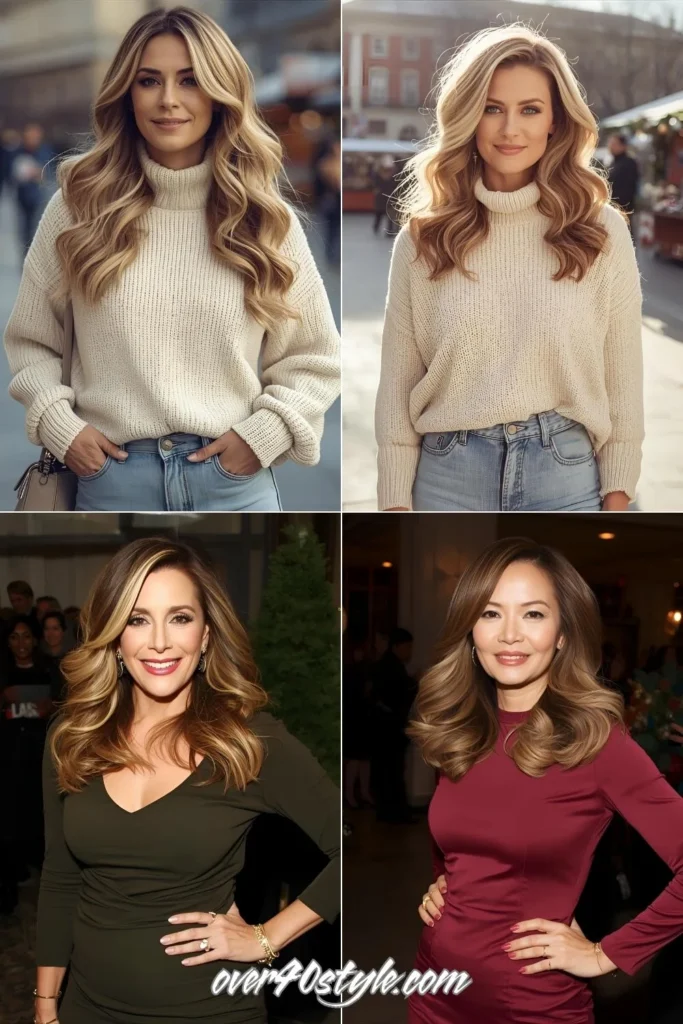
The lighter base brightens your face on its own, even before the highlights add dimension. This combination covers grey hair effectively, especially if your natural color before greying was a lighter brown shade. The blonde highlights add visual interest that makes the color more dynamic than a single shade.
Who Should Choose This Look
This style suits women with cool or neutral skin tones who want noticeable brightening without going fully blonde. It flatters fair to medium complexions by creating contrast that stays soft rather than harsh.
In winter, this lighter combination helps counteract how low natural light can wash out your complexion. The brighter tones catch indoor lighting and photograph well at holiday events and gatherings.
Care Requirements and Styling
This color needs medium to high maintenance. The lighter base makes root regrowth more visible than darker versions, so plan for touch-ups every 4–6 weeks. Blonde highlights also need regular toning to prevent brassy, yellow tones—especially since indoor heating can affect how color holds.
This combination looks best with volume. Try bouncy blowouts or soft curls that show off the dimensional tones. Always use heat protectant during winter, since dry air combined with hot tools can cause both color fading and breakage.
Related Read: Looking for another rich, age-defying shade? Don’t miss The Secret to a Softer, More Youthful Look: Cinnamon Chocolate Brown Hair. This trending tone blends warmth and depth for a flattering finish that brightens mature complexions beautifully.
Working with Your Colorist
Discuss with your stylist to find the lightest base shade your hair can handle while staying healthy. Pushing the base color too light can damage mature hair. It’s better to keep a slightly darker base and add more highlights for brightness instead.
5. Solid Milk Chocolate Hair Color
Sometimes a simple approach works best. Solid milk chocolate hair color proves you don’t need highlights to look current and polished. This method focuses on grey coverage, easy upkeep, and classic style over trendy dimension.
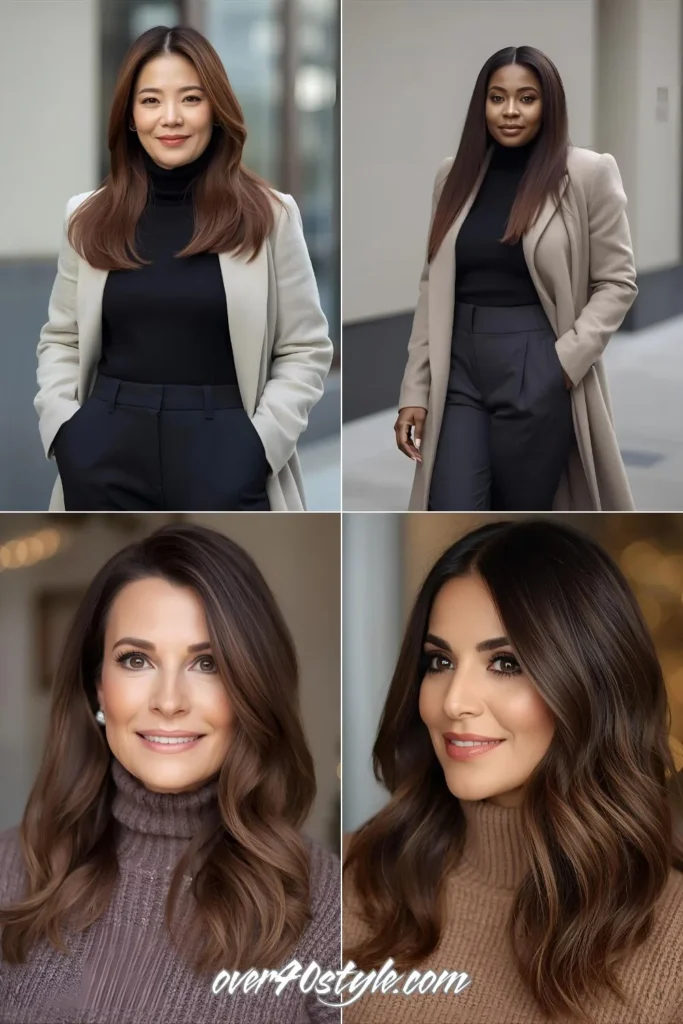
A uniform chocolate shade creates a professional look that works anywhere—from office settings to weekend outings. Rich solid color looks glossy when well-maintained and catches light naturally without needing highlights for visual interest.
Who Should Choose Solid Color
This option suits minimalists, budget-conscious women, or anyone with a sensitive scalp who prefers less chemical processing. Solid milk chocolate works with all skin tones when you choose the right depth of brown.
In winter, the grounded richness of solid color pairs well with chunky knits and textured fabrics. Since there are no highlights to maintain, you’ll spend less time and money on salon visits during the busy holiday season.
Maintenance and At-Home Care
Solid color needs low to medium maintenance. Plan for root touch-ups every 4-6 weeks. Many women can handle this at home with quality box color. You won’t need toning appointments, which saves both time and money compared to highlighted styles.
Solid color looks best in sleek, polished styles where the uniform shade and glossy finish stand out. Use weekly glossing treatments during winter to fight dullness from indoor heating and keep the rich sheen.
Choosing Your Shade
Try semi-permanent color first if you’re not sure about your ideal milk chocolate shade. Without highlights to add dimension, the single color needs to flatter your skin tone perfectly. Take time to find the exact right shade for you.
6. Milk Chocolate with Honey and Golden Highlights
Mixing honey and golden highlights with a milk chocolate base creates warm, multidimensional color that flatters olive, tan, and deeper skin tones. This technique weaves several warm blonde shades—from pale honey to rich golden—through the chocolate foundation.
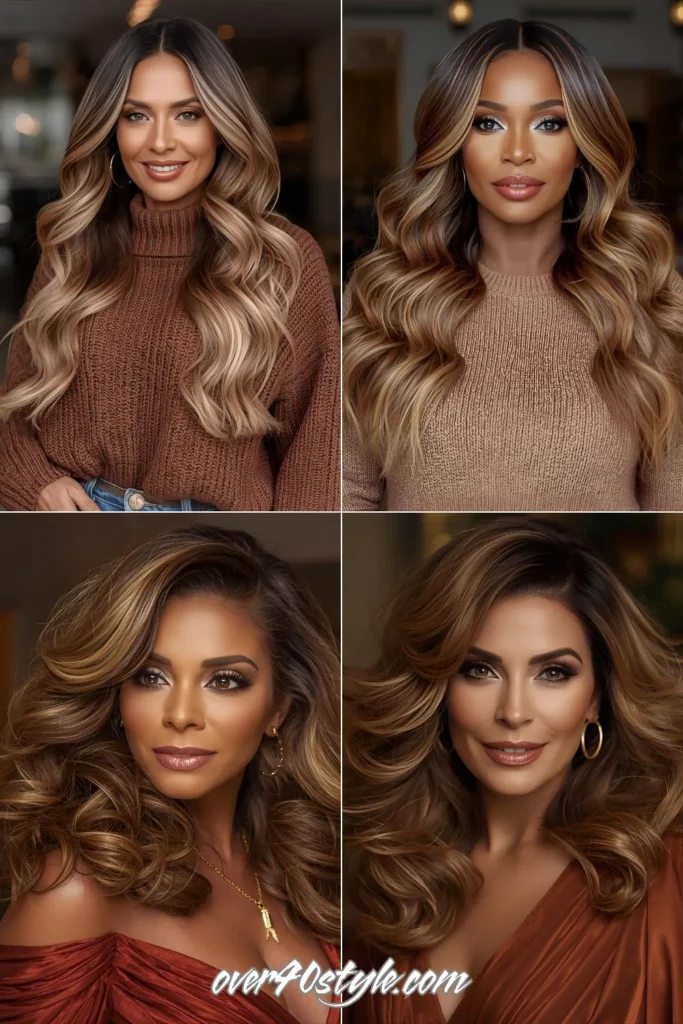
The varied tones create natural dimension similar to sun-lightened hair. Each highlight shade reflects light differently, adding visual depth. This works especially well for women with warm undertones who find single-shade highlights too flat.
Best Candidates for This Style
This combination suits women with warm, olive, or tan skin tones. If you tan easily and look good in earth-tone clothing, this variation will enhance your natural coloring.
Honey tones might seem like a summer color, but they actually add welcome warmth during cold winter months. Golden highlights catch indoor lighting well and create a healthy glow that helps offset the pale complexion many women get in winter.
Related Read: If you’re drawn to richer, more dramatic tones, don’t miss Velvet Chocolate Brown Hair: 7 Stunning Shades Every Woman Over 40 Needs. These bold, glossy shades offer a deeper twist on brunette beauty — perfect for anyone ready to elevate their winter hair game.
Care and Styling Advice
This color needs medium maintenance. Multiple tones require professional application and toning every 4-6 weeks to keep the honey and golden shades distinct. Root touch-ups can wait 6-8 weeks because the blended mix of tones hides regrowth better.
Show off the multidimensional color with textured styling. Beach waves, loose curls, or tousled looks display the various highlight shades best. Use a color-protecting leave-in conditioner during winter to prevent fading from dry indoor heat.
Color Consistency Tips
Keep all tones consistently warm rather than mixing cool ash shades with honey highlights. Combining warm and cool undertones creates a muddy look instead of cohesive, flattering color.
7. Face-Framing Blonde Highlights on Milk Chocolate Hair
Strategic face-framing blonde highlights deliver high impact with low commitment. This technique places highlights only around your face—at the temples, cheekbones, and front sections—while keeping the rest of your hair solid chocolate.

The brightness around your face draws attention to your features and creates a subtle lifting effect. It minimizes focus on forehead lines or grey at the temples. Since the back and underneath sections stay solid color, you’ll spend less time and money on maintenance than traditional full-head highlights.
Who Benefits Most from This Style
This option works well for budget-conscious women, first-time highlight clients, or anyone who wants to try highlights before committing to a full head of color. The placement can be customized to flatter any skin tone.
Face-framing highlights catch indoor lighting nicely, which matters during winter when you spend most of your time inside. The strategic brightness photographs well at holiday events without requiring the upkeep of all-over highlights throughout the season.
Maintenance and Styling Tips
This style needs low to medium maintenance since only the front sections are highlighted. Schedule touch-ups every 6-8 weeks. Appointments take less time and cost less than full highlights because the back stays solid color.
Style your hair down or in ways that show off the face-framing pieces. Try side-swept sections, loose waves around your face, or half-up styles that feature the dimensional front. Apply a leave-in treatment to the highlighted areas before going outside in harsh winter weather.
Placement Guidelines
Ask your colorist to concentrate color from the temples forward. Placing highlights too far back reduces the face-framing effect. The goal is natural-looking brightness that enhances your features without obvious highlights through the back sections.
Matching Your Skin Tone to the Right Highlights
Your skin’s undertones dramatically affect which milk chocolate hair color with highlights variation flatters most. Understanding whether you have warm, cool, or neutral undertones ensures your color choice enhances rather than clashes with natural coloring.
Warm Undertones (Golden, Peachy)
Your skin has yellow or golden base if you tan easily, gold jewelry flatters you, and earth tones look best. Choose caramel highlights, honey tones, or golden blonde on your milk chocolate base. These warm highlights enhance natural coloring, creating harmony between hair and complexion. During winter, warm tones prevent washed-out appearance under artificial lighting.
Cool Undertones (Pink, Bluish)
Cool undertones appear as pink, red, or blue tones in skin. You probably burn rather than tan, silver jewelry flatters more than gold, and jewel tones look stunning. Opt for blonde balayage with neutral to slightly cool tones, or light milk chocolate hair color with highlights in honey blonde shades avoiding clash with pink undertones. Skip overly warm caramel that can make cool skin appear ruddy.
Neutral Undertones (Balanced)
Neutral undertones mean virtually any milk chocolate hair color with highlights variation flatters you. You wear both gold and silver jewelry, tan moderately without burning excessively, and look good in most colors. Experiment freely with any highlight shade from caramel to blonde, or mix multiple tones for maximum dimension.
Simple Vein Test
Check inner wrist veins in natural light. Green-tinted veins indicate warm undertones, blue or purple veins suggest cool undertones, and inability to definitively tell means you likely have neutral undertones.
Winter can make skin appear more sallow or pale, sometimes complicating undertone determination. Consider consulting professional colorists who assess undertones in various lighting conditions, recommending the most flattering milk chocolate hair color with highlights for your unique coloring.
At-Home or Salon: Making the Smart Choice
Deciding between professional salon services and at-home coloring significantly impacts your milk chocolate hair color with highlights results. While budget matters, understanding which techniques need professional expertise prevents costly mistakes and potential hair damage.
You Might Also Like: Love rich, dimensional brunettes? Deep Cocoa Hair Color is a bold, polished option for women over 40 who want depth, shine, and effortless grey blending with a luxurious twist.
Salon-Essential Techniques
Blonde balayage absolutely requires professional application. Hand-painting technique, proper sectioning, and bleach timing demand expertise from professional training. Attempting balayage at home typically creates patchy, brassy results costing more to fix than original salon service would have cost.
Multiple highlight shades like honey and golden combinations need professional color formulation and placement strategy. Skilled colorists understand how to blend various tones seamlessly, creating natural dimension rather than striped effects that scream “home job.”
Heavy grey coverage combined with highlights requires professional color matching ensuring base milk chocolate adequately covers grey while highlights blend naturally. This dual-process technique demands timing precision difficult achieving at home, especially for first-timers.
At-Home Success Stories
Solid milk chocolate hair color without highlights translates beautifully to at-home application. Quality box colors like L’Oréal Paris Excellence Créme or Clairol Nice’n Easy in medium to dark brown deliver reliable grey coverage and rich color at fraction of salon costs.
Root touch-ups between salon highlight appointments can be managed at home once your colorist provides exact shade match. Many professional lines offer retail root touch-up products specifically formulated for between-appointment use.
Winter At-Home Tips
Choose ammonia-free formulas minimizing damage during winter’s already-drying conditions. Madison Reed offers online subscriptions with customized formulas delivered to your door. Garnier Nutrisse provides nourishing formulas with fruit oil concentrates combating winter dryness while coloring.
Always perform strand tests before applying any at-home color, especially during winter when hair may be more porous from heating damage. Tests reveal how your hair reacts and whether shade matches expectations before committing fully.
Styling Tips That Showcase Your Color
Right styling techniques showcase your milk chocolate hair color with highlights beautifully, particularly during winter’s social season filled with holiday gatherings and celebrations.
For Caramel Highlights
Create loose, beachy waves using 1.25-inch curling wand. Wrap random sections away from face, leaving ends uncurled for modern finish. Varied texture catches light differently, showcasing dimensional caramel tones throughout milk chocolate base. Finish with texturizing spray rather than heavy products that dull shine during winter months.
Style Break: Hair’s just one part of the look! If you’re wondering how to stay chic and comfortable this season, don’t miss How to Wear Leggings Over 40. It’s full of flattering, age-appropriate outfit ideas you’ll actually want to wear.
For Blonde Balayage
Embrace natural texture showcasing gradual color transition. Apply curl-enhancing cream to damp hair and air-dry or diffuse for soft waves highlighting where chocolate transitions to blonde. This effortless style works perfectly for winter weekends and casual gatherings without excessive styling.
For Subtle Lowlights or Solid Color:
Sleek, straight styles allow rich chocolate color to shine brilliantly. Use flat iron on low to medium heat protecting hair health during dry winter months, creating glossy smoothness reflecting light beautifully. Uniform appearance looks professional and polished for winter business settings.
Volume Techniques for All Styles:
Volumizing methods enhance the fuller appearance dimensional color creates. Tease roots gently at crown before styling, or use volumizing mousse at roots before blow-drying. During winter, static can work in your favor for added lift—just control flyaways with light oil on lengths.
Winter hat-wearing flattens hair, so master the quick fix: spray dry shampoo at roots, flip head upside down and shake vigorously, then use fingers reshaping style. This preserves your milk chocolate hair color with highlights without excessive restyling that fades color unnecessarily.
Common Mistakes to Avoid
Learning from others’ errors saves time, money, and potential hair damage when pursuing milk chocolate hair color with highlights. These common mistakes particularly affect women over 40, so understanding them prevents disappointing results.
Figure-Flattering Fashion Tip: Great hair deserves a great outfit. If you have an apple-shaped body, check out How to Dress an Apple Body Shape Over 40 for smart, confidence-boosting outfit strategies that highlight your best features.
Going Too Light Too Fast
Dramatic lightening in one session often results in damaged, brassy hair that ages rather than flatters. Mature hair processes differently—it’s often more porous, thinner, and more prone to breakage. Gradual lightening over two to three sessions allows hair maintaining integrity while achieving desired results.
Wrong Blonde Tone
Not all blonde highlights suit milk chocolate bases. Cool ash or platinum blonde creates harsh contrast emphasizing fine lines and making skin appear sallow—particularly problematic during winter when complexions already lack summer glow. Choose warm honey, golden, or butterscotch blonde harmonizing with chocolate tones and flattering mature skin.
Over-Processing
Women over 40 often experience thinner, more delicate hair due to hormonal changes. Over-processing with excessive highlights or too-frequent coloring leads to breakage, dullness, and texture damage difficult repairing. Limit highlighting to every eight to twelve weeks, focusing on strategic placement rather than full-head coverage.
Ignoring Grey Roots
While some highlight styles camouflage regrowth well, ignoring grey roots too long creates obvious lines appearing unkempt. Schedule root touch-ups before grey becomes prominent—typically every four to six weeks depending on grey percentage and growth rate.
Skipping Toner
Toner transforms brassy, yellow highlights into beautiful golden or honey tones. Skipping toner allows unwanted warm tones dominating, aging your milk chocolate hair color with highlights appearance. Budget for toner applications every four to six weeks as non-negotiable maintenance.
Top Tools for Maintaining Milk Chocolate Hair with Highlights
Stay glossy, vibrant, and winter-proof with these 5 Amazon favorites.
| Product | Why It’s Great | Link |
|---|---|---|
| 1. Clairol Shimmer Lights ConditionerPurple toner for blondes/caramel highlights | Neutralizes brassiness in highlighted areas. Essential for maintaining fresh caramel and blonde tones on milk chocolate hair. | View on Amazon |
| 2. Pureology Hydrate ShampooSulfate-free + color-safe | Keeps milk chocolate color rich and hydrated without fading. Sulfate-free formula protects color-treated hair. | View on Amazon |
| 3. Olaplex No. 8 Moisture MaskDeep conditioning + bond repair | Restores dry, highlighted hair with moisture and strength. Ideal for over-40 hair prone to thinning or breakage. | View on Amazon |
| 4. CHI 44 Iron Guard Heat SprayThermal protection for styling | Shields your color and hair health from heat tools. Prevents fading and split ends. | View on Amazon |
| 5. John Frieda Clear Shine GlossAt-home glossing treatment | Adds mirror-like shine to milk chocolate tones. Quick, easy fix for dull winter hair. | View on Amazon |
Plus-Size Style Inspiration: Style has no size limit. Visit our Plus Size Style Guide for Women Over 40 for outfit ideas, confidence tips, and wardrobe essentials that flatter and empower at every size.
FAQ About Milk Chocolate Hair Color with Highlights
Which highlight color lasts longest on milk chocolate hair?
Caramel highlights demonstrate longest-lasting results because warm tones blend naturally with base and camouflage grey regrowth effectively. As highlights fade slightly over six to eight weeks, they create natural dimension rather than obvious roots.
Can I do blonde balayage at home?
Attempting blonde balayage at home is strongly discouraged. The technique requires professional hand-painting skills, precise sectioning, and expert bleach timing. Mature hair processes bleach unpredictably, increasing damage risk significantly. Home attempts typically result in patchy results requiring expensive professional correction.
How often do I need touch-ups?
Touch-up frequency varies by style. Solid color needs roots done every four to six weeks. Caramel highlights require refreshing every six to eight weeks. Blonde balayage extends to eight to twelve weeks for base with toning every four to six weeks. Face-framing highlights need attention every six to eight weeks.
Will highlights damage my thinning hair?
Highlights involve chemical processing that can damage hair if not done carefully, but modern techniques minimize risk considerably. Request bond-building treatments like Olaplex during highlighting. Choose balayage over traditional foils requiring less processing. With proper care, milk chocolate hair color with highlights can enhance thinning hair by creating dimensional volume.
Which style best hides grey?
Caramel highlights on milk chocolate base provide superior grey coverage. Varied tones create dimension camouflaging grey strands as they emerge. Warm caramel blends with grey naturally rather than creating stark contrast. For heavy grey coverage exceeding 50 percent, solid milk chocolate offers more reliable complete coverage.
What’s the cost difference between salon and home coloring?
Professional highlighting ranges from 150 to 300 dollars depending on location and technique complexity. At-home box color for solid milk chocolate runs 10 to 20 dollars. Consider that professional highlights every eight weeks equals roughly 600 to 1,200 dollars annually, while at-home color costs 120 to 240 dollars yearly.
Can I switch between different highlight styles?
Switching requires careful consideration avoiding over-processing. Moving from caramel to blonde balayage means additional lightening stressing hair. Transitioning from highlights to solid color is gentler. Give hair three to four months between major changes, especially during winter when hair already faces environmental stress.
